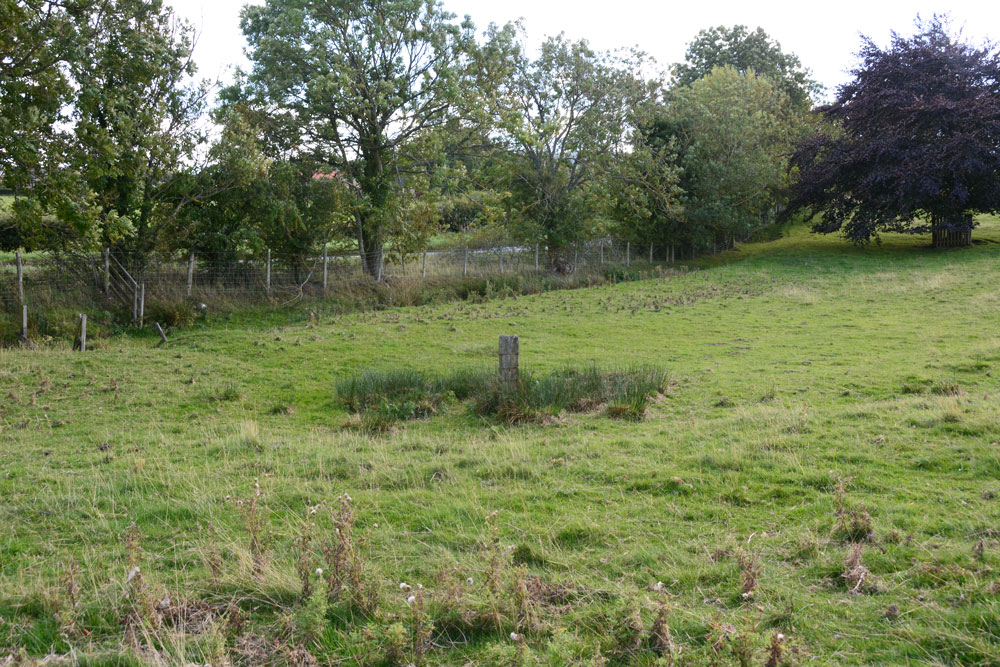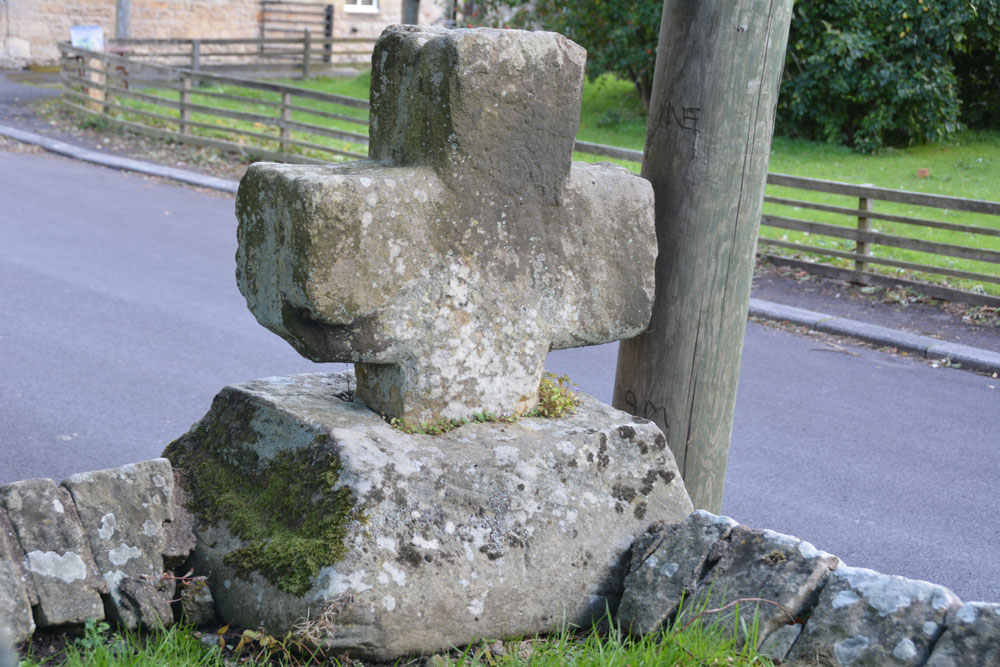Contributory members are able to log private notes and comments about each site
Sites Anne T has logged on trip number: 100 (View all trips)
View this log as a table or view the most recent logs from everyone
Hawklemass Well (Whittingham)
Trip No.100 Entry No.2 Date Added: 24th Sep 2018
Site Type: Holy Well or Sacred Spring
Country: England (Northumberland)
Visited: Yes on 23rd Sep 2018. My rating: Condition 2 Ambience 4 Access 4

Hawklemass Well (Whittingham) submitted by Anne T on 24th Sep 2018. The well site, seen from slightly higher up the slope, just to its north west, looking east.
(View photo, vote or add a comment)
Log Text: Hawklemass Well, Whittingham: From St Bartholomew's Church in Whittingham, we drove round to this site, parking on the verge near the footpath sign to the church, which was quarter of a mile over the hill. Stepping over the stile into the field, there was a boggy patch marked by a substantial post, such as I've seen on a number of other wells, including Robin Hood's Well in Colwell. Sited at the bottom of a slope, it was a natural place to find such a well.
At the hedgerow to the east of the well, but just to the west of the road, there was a small gully or drain coming down alongside the hedgerow, which seemed to form a rectangular pool in the grass near the well. The OS map shows two drains or small streams which meet near this point.
There was no sign of any stone or brick structure to indicate this has been a well basin or trough. There is no record of this well on the modern OS map, neither on HE or Pastscape, or any other local record on the internet - curious.
On such a nice sunny afternoon, this site seemed entirely peaceful and normal - I was disappointed not to meet the Hawklemass Ghost mentioned by The Northern Antiquarian!
Holy Trinity (Old Bewick)
Trip No.100 Entry No.3 Date Added: 24th Sep 2018
Site Type: Ancient Cross
Country: England (Northumberland)
Visited: Yes on 23rd Sep 2018. My rating: Condition 3 Ambience 5 Access 4

Holy Trinity (Old Bewick) submitted by Anne T on 24th Sep 2018. The consecration cross on the southern column of the sanctuary.
(View photo, vote or add a comment)
Log Text: Ancient crosses, Holy Trinity Church, Old Bewick: This is truly a real gem of a church, with great historical notes in a binder in the church. I took these temporarily out of the folder and read out from them as we went round and saw the individual features identified. There was another set of notes, from a talk given in 2017 which I also photographed and will transcribe into my walk journal when time allows.
In some ways, this church is more enigmatic than Escombe Saxon Church, and is smaller. It comprises a nave, a chancel and a semi-circular apse which has been beautifully decorated.
There is so much to look at – original Norman windows. A 14th century effigy. Huge slabs in the west wall. There is what is described as a cross shaft in corner of porch. There is a lovely consecration cross on south pillar of sanctuary. The carvings on north pillar of chancel are particularly nice.
The cross base (?) in the churchyard that I photographed on 13th April 2014 no longer appeared to be there.
Percy's Cross (Beanley)
Trip No.100 Entry No.4 Date Added: 26th Sep 2018
Site Type: Ancient Cross
Country: England (Northumberland)
Visited: Yes on 23rd Sep 2018. My rating: Condition 3 Ambience 3 Access 4

Percy's Cross (Beanley) submitted by Anne T on 26th Sep 2018. View of Percy's Cross, looking eastwards towards the now disused railway line. I'm standing in the middle of the field being used for caravan storage looking over the cross with its 19th century railings.
(View photo, vote or add a comment)
Log Text: Percy's Cross, near Beanley, Northumberland: We didn’t have enough time to head up the hill behind Old Bewick, as it had gone 5pm, and there was about a mile each way to walk to the first site. Having spotted Percy’s Leap and Percy’s Cross on the OS map, we decided to stop off and look at these instead.
It was difficult to park just off the busy A697, but we found the wide entrance to a farm track opposite the sawmill, on the western side of the road, and walked back to the farmhouse on the opposite side of the road.
We could see the cross from the gate into their garden, but the gate had a huge chain and even larger padlock. Fortunately, we spotted a track into the wood a metre or so to the north of the edge of the garden. Following this for about 100m led us to a gateway into a field being used partly for caravan storage, and this gate gave access to the very overgrown cross which was surrounded by iron railings with very sharp ornamental spikes.
Worth stopping off to see, although I wondered if this, being dated at 15th century, was too late to post on the Portal, although it is classed as a wayside cross, so I've posted it, along with its associated 'Percy's Leap' erratic rock site.
Percy's Leap (Beanley)
Trip No.100 Entry No.5 Date Added: 26th Sep 2018
Site Type: Natural Stone / Erratic / Other Natural Feature
Country: England (Northumberland)
Visited: Yes on 23rd Sep 2018. My rating: Condition 2 Ambience 2 Access 5

Percy's Leap (Beanley) submitted by Anne T on 26th Sep 2018. Standing near the gate to the enclosure, looking westwards to both the erratic stones. They are 9.5 of my paces - around 9 metres apart.
(View photo, vote or add a comment)
Log Text: Percy's Leap, Beanley (associated with Percy's Cross): Labelled ‘Percy’s Leap’ on the OS with a semi-circular enclosure marked against the edge of the road. Having the car pointed in this direction, and curious to see this site, as it sounded related to Percy’s Cross (by the name), we headed up and parked in the small layby by the information/interpretation board.
There is a low stone wall next to the layby and a gate leading into a semi-circular walled enclosure which is heavily littered and not pleasant. Inside the enclosure a two large stones, which look as if they have been dumped there for effect. In fact, these are two glacial erratics. There are two other interpretation boards inside the enclosure.
The first interpretation board inside the enclosure reads: “The Red Rose of Lancaster. For 30 years between 1455 and 1485 the two families of Lancaster and York fought for the Crown of England. Between 1461 and 1464 the North of England was the centre of activity in the Wars of the Roses. Edward IV supported by the Yorkists was on the throne which he had taken away from the weak Henry VI After the Lancastrian defeat in 1461 at Towton in Yorkshire Henry VI and his wife, Queen Margaret of Anjou, fled to Scotland to plan another campaign against Edward. / Sir Ralph Percy third son of the second Earl of Northumberland, changed sides four times in the Wars of the Roses. In Spring 1463 he was in the Lancastrian fold as were his castles at Bamburgh and Dunstanburgh. In 1464 Edward IV decided to seek a truce with Scotland to enable him to take action to crush the Lancastrians to the north. Lord Montague, younger brother of Warwick the Kingmaker, was sent to escort a Scottish mission through Northumberland in safety. / Learning of Lord Montague’s attempts to meet the Scottish mission the Lancastrians tried to ambush the Yorkists in Durham but this failed when Montague was alerted to the threat. Before proceeding further north Montague increased his forces at Newcastle. His path to Scotland was barred here at Hedgeley Moor by the Lancastrian troops of Sir Ralph Percy and the Lords Hungerford and Ros. / At the start of the battle Lords Hungerford and Ros decided to leave the field with their troops. Montague’s and Percy’s troops attacked head on. Sir Ralph Percy is reputed to have charged the Yorkist line at which his horse is said to have leapt and was wounded doing so. Sir Ralph fell soon afterwards and said at his death, “I have saved the bird in my bosom”. It is not known whether his final words meant that he died for his rightful monarch, Henry VI, or whether he had kept the secret of where Henry and Margaret were hiding. / Montague’s troops finished off the remaining Lancastrians quickly. Less than a month later the two armies met at Hexham where the Yorkists won a convincing victory which ended the Wars in the north for the time being. / Legend has it that the two stones in front of you mark the leap of Sir Ralph’s horse at the height of the battle.”
There is no record on HE for this site.
St Bartholomew's Church (Whittingham)
Trip No.100 Entry No.1 Date Added: 24th Sep 2018
Site Type: Ancient Cross
Country: England (Northumberland)
Visited: Yes on 23rd Sep 2018. My rating: Condition 3 Ambience 4 Access 4

St Bartholomew's Church (Whittingham) submitted by Anne T on 24th Sep 2018. Looking south east across the cross head and base, showing its slightly damaged/chipped lower arm (towards the centre, left of the photo). Historic England simply says the cross is 'medieval'.
(View photo, vote or add a comment)
Log Text: Ancient Cross, St Bartholomew's Church, Whittingham: [please note: there are steps up to the churchyard and church; there may be wheelchair access which we didn't spot on the day - please check before visiting]. This cross was remarkably easy to spot, as it was sited on the corner of the wall to the south east of the churchyard, right by a parking spot for one car at the base of the steps into the churchyard.
There was an informative church guide, although the language was slightly archaic and we had to re-read several of the passages to ensure we were interpreting these correctly.
The guide reads: “Whittingham [spoken as “Whitingjum”, or “Witnjum”] is a name which has evolved from the Anglo Saxon Hwita-ing-ham, meaning “the home of Hwita’s people”. The present church stands on rising ground which could have been the meeting place of Hwita’s people for their Moots before it became the site of a church.
Our visit was interrupted by two people coming in to prepare for the 4pm service. As they were praying at the altar, it seemed disrespectful to continue taking photographs.
The church guide is very useful in explaining all the features, and I’ve emailed one of the church wardens to see if it’s possible to get hold of a copy of the detailed guide mentioned both in the church and on one of the websites I’ve visited (the Northern Vicar’s blog).
There is still Saxon work to be seen in the tower, with its semi-circular arch and squared, heavy side, dated to 900AD by the ‘long and short’ stone work (as we saw at Heddon on 20th Sept, last week).
There is also a section of Saxon stonework in the north aisle wall, forming what would have been a half-arch which was later filled in, and it thought to be the entrance to a small side chapel in the original church.
The guide goes onto say: “Almost certainly there had been another earlier church built on this site, but its possible form can only be conjectured (see the detailed guide). There is a record of a consecration at 735AD. It is also likely there was a yet earlier church existing at the time of the Synod of 684AD.
The guide also mentions, as one of the ‘curios’ a stone on the aisle walling to the left of the porch, at the wall’s left hand corner. Just to the right of the top of the buttress is a stone bearing two arrows (Norman chevrons). “This could be an inserted fragment from some demolished structure [or are these natural fault lines in the stone?].
We popped across the road to see the still working water fountain, although this is too recent a feature to log on the Portal.
St. Helen's on the Lea (Old Cambus)
Trip No.100 Entry No.2 Date Added: 30th Sep 2018
Site Type: Sculptured Stone
Country: Scotland (Scottish Borders)
Visited: Yes on 29th Sep 2018. My rating: Condition 2 Ambience 4 Access 4

St. Helen's on the Lea (Old Cambus) submitted by Anne T on 30th Sep 2018. The almost complete hogback stone, to be found at the southern side of the eastern gable wall of the church. Canmore 59948 describes some decoration on the hogback, but there was nothing we could see. The stone was almost buried in knee high grass that covered the site.
(View photo, vote or add a comment)
Log Text: Hogback at the ruins of St Helen's Chapel, Old Cambus: We found the first hogback easily – at the northern side of the east gable wall, but the second one we hunted for but were unable to find. The cross incised slab we searched for ages, even matching up the angles of the stone to the masonry behind on the Canmore images, but drew a blank. The site was knee deep in grass, with tumbles of stone underneath, so it could have been anywhere. A strimmer would have helped! Similarly with the fragment of hogback on the southern side of the chancel. We found many tumbled stones in the grass, but even looking closely for the tegulations, we didn’t locate it, which was disappointing.
The information board which sits near the junction of the road to the quarry to the footpath to the chapel and Siccar point reads:
“Proceed from here, through the kissing-gate, past the ruin of St Helen’s Chapel and along the top of the steep sea-braes to Siccar Point, arguably the most important geological site in the world. In 1788 it gave James Hutton final proof of his revolutionary claim that the Earth is eons old He based his claim on painstaking observation of rocks and soil over a period of some 30 years. / James Hutton (1726-1797) farmed locally near Reston and was a self-taught geologist. Having already published his theory, he was on a mission to establish the evidence. Before discovering the proof at Siccar Point, by boat with his friends Sir James Hall and John Playfair, Hutton knew what he was looing for and had an idea of where to find it. He sent Sir James, a local landowner from Dunglass and also a geologist, to review the area before embarking on their boat trip below the braes. Sir James may have done this by observing that the stone used to construct field boundaries in the vicinity was (and still is) a combination of rock from above and below the uncomfority (red sandstone and greywacke). / Hutton’s theory released science and philosophy from limitations of the biblical age of the earth (6,000 years old). Though bitterly disputed at the time, it is now accepted as a fundamental of science. James Hutton also expounded with authority of theories as diverse as the nature of light and methods of education, and was a significant agricultural innovator and improver.”
Just before reaching the ruins of St Helen’s, someone has carved an old tree trunk into an L-shape with a toilet seat on top! Note: the gate to the field was locked, and we had to climb over the rather tall gate.
